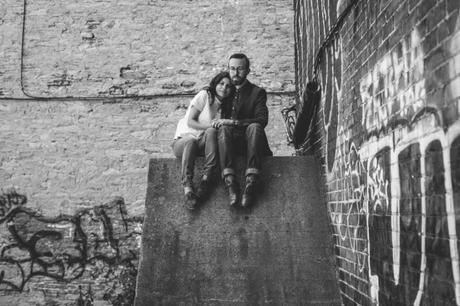
I have been following the powerful photography of Colin Boyd Shafer for years now. In the Interlove Project (2014-2016), Shafer created 50 black and white portraits of interfaith couples and families from throughout Canada. You could describe these families as Protestant and Jewish, or Catholic and Muslim, or atheist and Hindu. But instead, Shafer lets his subjects describe the nuances of their religious journeys and identities. And so, we meet a Catholic who became a Wiccan, a Hindu who became an atheist, a Muslim born to an intermarried Shia and Sunni couple who identifies with both. These Canadians, as individuals and as couples, illustrate the complexity and fluidity of the religious landscape.
Now, I am thrilled that Shafer plans to extend the Interlove Project to 50 interfaith couples in the US, starting this fall. If you are interested in being included, fill out the application now. The project is open to people who are in interfaith relationships, those from different sects or denominations of the same religion, those who may identify as having no faith, those who are spiritual but not religious, those in same-sex relationships, and those who identify as polyamorous.

Recently, I had a chance to ask Colin Boyd Shafer a few questions about the Interlove Project. Here’s our Q & A:
Miller: What first inspired you to chronicle interfaith couples?
Shafer: My previous project Cosmopolis Toronto focused on the diversity that exists in one city. I photographed one person from every country of the world who has migrated to Toronto. Doing this project made me think about other aspects of diversity, and one of those was diversity of relationships. I have lived in countries (like Malaysia) where interfaith relationships are highly discouraged, but in Canada I felt as though people would be willing and safe to open up about the experience. When we look at the news and see so much hate, I think its important to tell stories of love – especially when that love is between people of different beliefs. I agree with the headline in the Toronto Star’s piece on my project: “World Leaders could learn from these couples”.
Miller: What has been the reaction to the Interlove Project in Canada?
Shafer: I would say the project has been received very well. I know for the couples involved it has created a community, and for other interfaith couples who have seen the project it has given them a sense of belonging. I hope for some viewers who may have been doubtful as to the possibility of such relationships working, it may change their mind. Maybe INTERLOVE hasn’t been overly controversial because it isn’t trying to promote interfaith relationships and is instead trying to show that they do exist and they can work.
Miller: You’re embarking on the US version of this project at a time when many religious minorities are feeling threatened in the US. What effect might this have on the willingness of couples to tell their stories?
Shafer: That is an interesting question. I know even in Canada, for every 10 interfaith couples that saw the project, probably only one applied to participate. It is a big step coming out and telling your story in public. Unlike interracial relationships, interfaith couples are often hidden. Doing this project in the United States is especially important because I imagine such relationships have faced more opposition. I am definitely open to using pseudonyms of the participants because I believe that these stories need to be told regardless.
Miller: What are your goals in terms of what you want this project to convey?
Shafer: I hope it continues to provide a sense of belonging to the couples involved or to other interfaith couples who see this. I also hope it challenges some people’s preconceived notions about what relationships can work. It would be great if this project turns into a book that can reach people in countries outside of North America – in places where people may not even imagine ever being with someone of a different faith. With so many unhealthy relationships out there, it would be such a shame for a couple that are such a great match to not be able to be together just because of differences of faith. Ultimately, everyone wants to hear a beautiful love story, and Interlove delivers.
Photos copyright Colin Boyd Shafer
Susan Katz Miller is the author of Being Both: Embracing Two Religions in One Interfaith Family, from Beacon Press. She works as an interfaith families consultant, speaker, and coach. Follow her on twitter @susankatzmiller.
Advertisements
